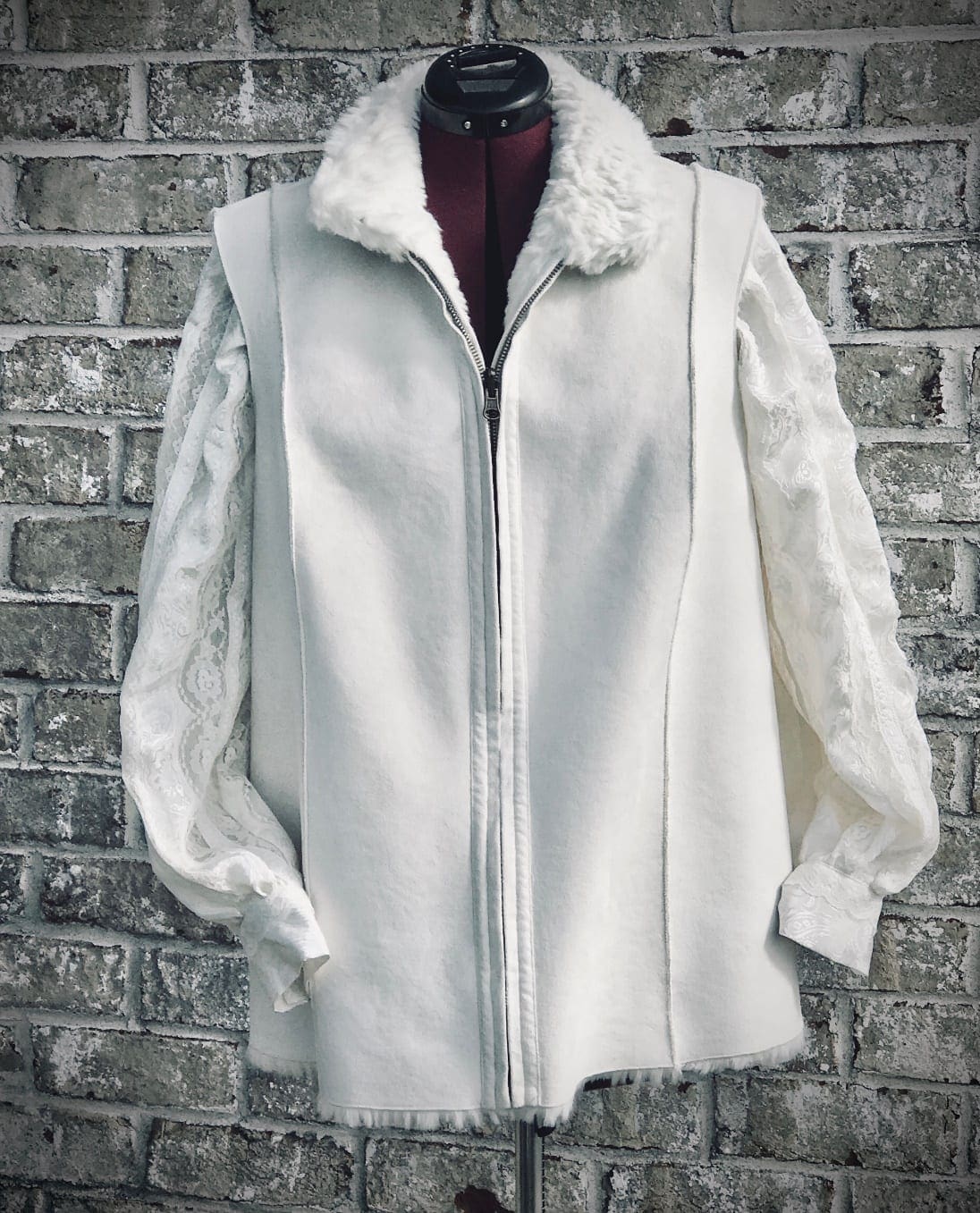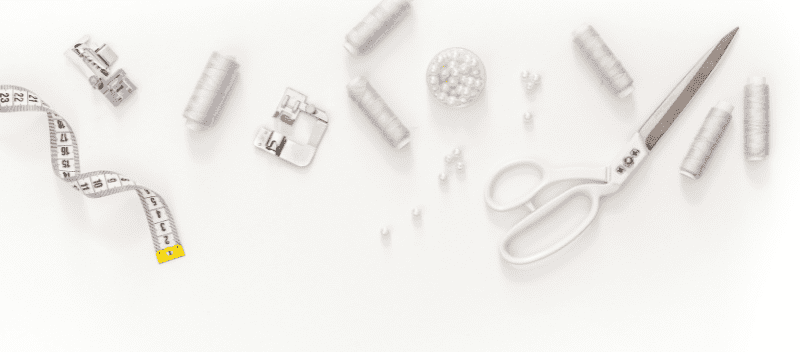Sew a Fast & Fabulous Velvet Banner in 8 Simple Steps

Velvet banners may look complicated, but they are easy to sew with this simple sewing tutorial. Once you master the basic process, you can size your banners to meet your needs, esp. for Renaissance festivals and theater productions.
Velvet Banner Materials needed:
¾ yd. velvet (you can cut 3-4 banner fronts)
¾ yd. satin (you can cut 3-4 banner backs
(1) 12” banner holder or ½” diameter dial rod
Small spool of general utility thread
¾ yd. Pellon Flex Foam Sew-in Stabilizer
1 piece of 8.5” x 11” paper (scrap paper is fine)
Optional: 2 yds. Decorative trim 3/8” – ½” wide
Monofilament thread (for trim sewing)
Velvet Banner Tools needed:
Sewing machine with straight, zig zag, and mock overlock stitches
Walking foot or leather foot
Optional: Bead/trim foot if adding trim
Straight pins
Rotary cutter
Scissors
Steamer
Disappearing ink marker or tailor’s chalk pencil
Step 1: Cut out your fabric pieces & template
For this velvet banner tutorial, you will need to cut (2) pieces of fabric that measure 11.5” wide by 22” long. One piece should be velvet, the other satin. If you plan on embroidering a design on your velvet like I did, start with a slightly larger piece until all embroidery is complete. Once finished, cut down the velvet to 11.5” by 22”.
If you have never worked with or embroidered velvet before, check out this post where I describe the process and necessary stabilizers.
Next, pick up your piece of paper. The 11” side should be horizontally positioned and the 8.5” side running vertically. Fold it in half like a book. With the paper still folded, draw a curve along the lower corner of the paper. Cut along line. Open your paper and lay it on top of velvet.

Line up the paper fold line with the center of the velvet. Pin in place or use fabric weights to secure it. This template will not cover all the fabric. There will be small amounts sticking out on the sides. This is fine. Just make sure you have centered the paper on the velvet. Using a rotary cutter, trim the lower corners of your velvet fabric using the paper as your template.

Once you have the velvet trimmed, discard the cuttings and remove the paper template.

Step 2: Pin fabric together
Pick up velvet fabric and set aside for a moment. Lay satin fabric right side up on table. Lay velvet fabric FACE DOWN on top of satin. Line up the edges and pin the VELVET side to the satin. Pin the vertical sides, bottom, and curved edges. Once the curves are pinned, you can trim away the excess satin to match the curves on your velvet.


Step 3: Assemble Your Velvet Banner
Select a straight stitch. Seam allowance should be 5/8”. Start sewing seam at top of right corner. Sew around entire banner until you reach the upper left corner. The TOP should be open. DO NOT sew it shut!

If you don’t have a walking foot to sew velvet, consider using a leather presser foot. It works really well!
Trim seam allowance to 1/4” to 3/8” wide.

Step 4: Cut out insert
Measure the distance between your side seams. It should measure approximately 10.25” wide. If it is slightly more narrow or wider, that’s completely fine! Cut a piece of Pellon Flex Foam Sew in Stabilizer this width x 20”. Lay it on top of the velvet side. Using a wash away marking pen or chalk pencil, trace the curves onto your Flex Foam. Use your banner seam as the cutting line guide. You will need to carefully lift the fabric to see the curves. Once you have it marked, set aside your banner and trim the lower foam edges.



Step 5: Turn and finger press seam
Turn your banner right side out. Finger press the seams as flat as you can. Be careful to not crush the velvet nap! If you have a steamer, you can lightly steam the seam flat from the SATIN side. The easiest way to steam it is to place a folded towel on your ironing board, position ONLY the seam on the towel and lightly steam the seam as you manipulate the seam with your fingers. NEVER IRON VELVET!!!!! Once you have the seams as flat as possible, it’s time to put in the foam insert.

Step 6: Insert the Flex-Foam
Carefully open the top seam and slide in the flex foam insert. Make sure your insert is placed against the lower curves. If you find that your foam isn’t fitting properly, carefully remove it from the banner and trim as necessary. You want a snug/slightly loose fit.
If the foam causes the banner to bow or the seams look stressed, remove it and trim it until you get a good fit. The foam will NOT touch the top of the banner. It will lay a few inches lower. This is the way it should fit. We need the fabric ease to create the casing.


Once you have the foam fitting properly, pin it in place along the seam. This will hold it in place while we sew the trim.

Step 7: Sewing the Velvet Banner trim (Optional)
NOTE: This step is completely optional. If you decide not to add trim, proceed to Step 8.
If you want to sew a trim along your banner, now is the time to do so. Set your machine to a zig zag stitch, thread the needle with monofilament thread and the bobbin with a color matching thread. Begin at the upper right corner and slowly sew your trim to the banner.
You may need to change from the walking foot to a standard beading foot or trim foot, depending on your selections. Be sure to remove pins before sewing over them. If you want to sew the trim by hand, that’s perfectly fine! Just use a monofilament thread and make sure the trim is securely anchored to the banner edge. Once you have the trim sewn, cut off any extra and remove the pins.

LEAVE the top open!

Step 8: Sew the Velvet Banner casing
Pin the top closed. Using a general sewing thread (color matched to your banner) sew the edges shut using a mock overlock or zig zag stitch. Do NOT sew over pins!!! Fold the edge down 1.5” against the satin side. Make sure that the fabric is smoothed out and lays flat. Pin along the FOLDED edge.

Turn under your lower edge ½” and pin thru all layers.

You can either machine stitch OR hand stitch along the folded edge. Machine stitching is very secure but is visible on the velvet side. Hand stitching with a whip stitch is invisible on the right side and gives a professional look.

Once you have the casing sewn in place, remove all pins and insert your dowel rod. You are officially done!

I hope this Velvet Banner tutorial helps you with your next velvet banner project. If so, please consider sharing it on social media and with your sewing friends. If you have a question, please leave it in the comments below.
Please note: This article does contain affiliate links.
We are a participant in the Amazon Services LLC Associates Program and its affiliate advertising programs which are designed to provide a means for us to earn fees by linking to Amazon.com and its affiliated sites.
There is no additional cost to you when you make a purchase through any of my affiliate links. Please consider supporting this blog.
CHRISTINE WARREN
Sewing isn’t just my job, it’s my passion. I’ve enjoyed sewing and needle working since I was very young.














